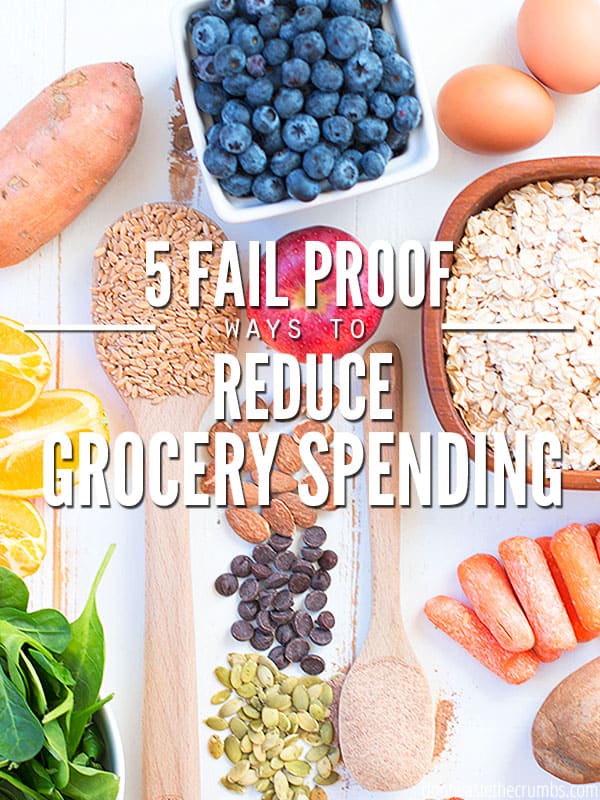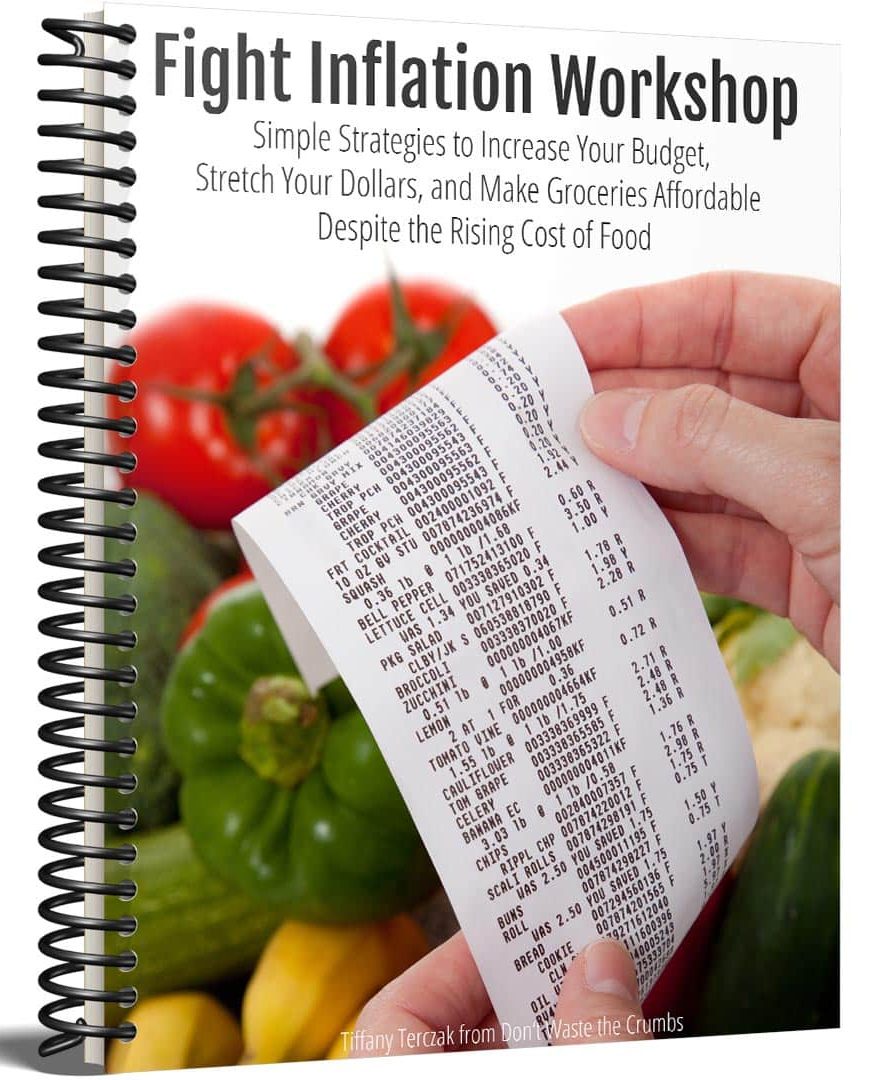Saving on food and still eating well can be done! These 5 fail-proof ways to reduce grocery spending can help you get the most bang for your buck month after month.

As a busy mom of two kids, I know how easy it is for grocery spending to get out of control.
The grocery budget is the most flexible expense that I have in my home. I can always run around the house to turn off lights and unplug appliances, but I won’t save nearly as much on electricity as I do when I manage my food spending well and reduce grocery spending!
Currently, our food budget for our family of 4 is under $400 a month. This is just food, not cleaning supplies or toiletries.
Since I’ve been helping families with saving on food and reducing grocery spending since 2012, I have found the average family overspends on food so much that they could buy a cruise ticket every month!
Some could buy 2.
Let that sink in for a minute.
Eating a real food diet with plenty of fruits and vegetables is very important to me, so I shop for it differently than most…
SAVING ON FOOD
For example, I once had a freezer-cooking day with friends. We all had the same recipes, same shopping list and went home with the same amount of food. The others spent between $200-$350, but I spent $85.
We made multiple meals of Butternut Squash Pasta Bake, Spaghetti Squash, Pesto Risotto, Giant Italian Meatballs and Fresh Tomato Sauce.
One family shopped at a local chain grocery store, another at a Natural Foods store and a third at Costco. I shopped primarily at Aldi supplemented with a few items from my home pantry.

HOW TO SAVE MONEY ON GROCERIES AND STILL EAT HEALTHY
When I’m shopping, I spend a few seconds on every item looking for the best value without compromising on my real food priorities. For the freezer cooking day, I made a couple of substitutions that didn’t change the final outcome of the recipes. For example:
- Prepared pesto sauce was $1.50, but the ingredients to make my own pesto were more than $10.
- One of the recipes called for a block of provolone cheese. Aldi only carried provolone slices, but they were half the price of buying a block of cheese anywhere else.
- I bought the slices and tore them into pieces instead of grating cheese from a block. My final recipes turned out just as delicious as the others!
My goal is to eat real food. Before buying anything prepared, I make sure there aren’t any preservatives or questionable ingredients listed on the labels.
But my goal is also to spend less! You can start saving on food too. Here are five fail-proof ways to start.

HOW TO SAVE MONEY AT THE GROCERY STORE
1. REDUCE GROCERY SPENDING BY PAYING WITH CASH.
We budget a certain amount every month, and when the money is used up, I’m done for the month.
If you find yourself running out of grocery cash too early in the month, start using a calculator as you shop so you can add as you go. You can even round each item up to the next dollar, so you know you’ve more than got it covered!
But here’s an insider tip – I like to save a bit of cash in a separate envelope for the last week of the month. This helps me make sure we can still buy what we might need if something comes up and we need to make a last-minute trip to the store.
2. KNOW HOW MUCH THINGS COST BY USING A PRICE BOOK
Is that “sale item” actually on sale for a good price?
I have a head for numbers and pay attention to food prices. But even still, numbers can get jumbled in my head. I write prices and discounts down in a pocket notebook (also known as making a price book). Then when prices drop significantly, I recognize the deal, even without coupons.
This also helps if your family prefers specific brands for certain items. In general, store brands will be cheaper than name brands, but occasionally those name brands go on sale for lower prices than the generic ones. By keeping track of the prices, you’ll know when your favorites are at the best price so you can really get saving on food!
A price book helps you keep track of prices at multiple stores too. You can compare prices between favorites like Trader Joe’s, Aldi, and Sam’s Club. Don’t forget to crunch numbers using online subscriptions too! Amazon subscribe and save is a GREAT way to get low prices on healthy food.
3. STOCK UP ON GROCERY ITEMS WHEN THE PRICES ARE AT THEIR LOWEST.
Speaking of the best prices, when I see a good deal, I like to buy enough so that I won’t have to buy again until the next sales cycle. For example, if pasture-raised chicken breasts are on sale, I take advantage and buy in bulk so I can use them in chicken meal prep plans like this one.
Utilize grocery store rewards programs and rebate apps to get great low prices too.
4. MEAL PLAN WITH THE FOOD I ALREADY HAVE ON HAND TO REDUCE GROCERY SPENDING.
Try a technique called reverse meal planning: Instead of shopping from a list of recipes, shop your pantry inventory first. Then look for the best deals you can find at the supermarket. And then meal plan around those foods. It can be a fun challenge to see what you can come up with using what you already have.
The Harvard School of Health says that meal planning and prep is a helpful and healthy eating strategy that reduces stress, helps with saving on food, and saves time. Good news!
Here are 25+ Cheap Healthy Meals (for under $10) to give you some great tasting, money-saving ideas.
5. BUY NECESSITIES FIRST, TREATS LAST.
Everyone likes a treat now and then, but it’s easy to go to the store and spend too much on cookies, chips, and soda and not have enough money for nourishing foods.
I buy essential foods first. Then, and only then, I pick a treat for one or two times a week. These treats can be homemade or store-bought depending on your budget and health priorities.
If you find yourself (or your shopping partners) adding too many impulse purchases to the cart, you may want to consider curbside pickup or grocery delivery. Yes, you’ll pay extra in shopper and delivery fees, but if it helps you stick to your list, you may still come out ahead.

SAVING ON FOOD FAQS
How do I save money on groceries online?
Consider your budget, as well as your real food priorities, and do some research! See if the prices can beat what you normally find in the store. Read more about online shopping, as well as my suggestions for which sites to start with, here.
How can I save money on food each month?
There are so many strategies for saving on food! Even the littlest steps can add up. Check out my list of Saving on Food Year-Round for some ideas!
How much money should I save for food?
Many factors are going to affect your grocery budget. To figure out how much your family might need, read all about how to make a frugal grocery budget here.
What is the cheapest grocery store?
I did a comparison of a few of the most popular grocery stores: Walmart vs. Aldi and Costco vs. Aldi to see which was the best deal.
MORE TIPS FOR SAVING ON FOOD
For more help saving on food, check out the FREE Fight Inflation Workshop. Inside you’ll get access to three AMAZING video sessions focused on saving money on groceries RIGHT NOW – despite the rising cost of food. Check it out here.
Once we get used to thinking about grocery shopping in a new way, it becomes second nature to spend less without sacrificing nutrition. If you’d like to learn more about saving on food, read these posts:
- How to Make a Frugal Grocery Budget
- 38 Ways to Save Money on Food Year-Round
- How to Budget for Bulk Purchases
- Best Foods to Make From Scratch
Do you need more saving tips? We talk about this in-depth in my course Grocery Budget Bootcamp (enrollment is currently closed, but you can join my FREE 5-day Crush Inflation Challenge and start saving money on groceries tomorrow!)









Is it worth it to shop at Aldi if the store is 1hr from you?
Tiffany’s insights on reducing grocery spending are a game-changer! As a mom juggling a tight budget, her fail-proof tips resonate. I’ve personally benefited from her emphasis on real food, not only for its health benefits but also for the significant cost savings. EmuCoupon has been my go-to for maximizing these strategies. How do you strike a balance between eating well and staying within your grocery budget?
I’d love to hear more about how to budget for those “sales” and still have what you need for regular meals. For example, you find cottage cheese is at your prices book lowest so you buy enough to get to the next sale, but you still have other things on your list and the cash in the envelope is low (maybe a week or two to go!) How can you do both? We
Hi Suz – in short, there’s a careful balance between the two. The key is to be strategic with your list making and shopping, every time, so that when instances like this happen, you have enough money for all of the above. I actually teach this exact concept in my class, http://grocerybudgetbootcamp.com!
I would like to mention one thing about ALDIs I find most of the food has alot of preservatives and stuff I don’t want in my body. The only thing I buy is the vegs and fruit but other than that I dont think it is very healthy for you.
THanks
Aldi has a jar of tomato sauce with no sugar and no preservatives and at a great price. You just have to read the labels.
I. know the regular prices for staples such as sugar and flour. When I see four pounds of sugar on sale at Kroger for $1.99, I skip it knowing whenever I am running low, I can get that 4# sugar at Aldi for $1.49. Same goes for flour, commonly used spices, coffee, bagged salad greens etc.
I review the E-coupons or each store i.e Kroger and Meijer and compare the prices in the weekly sale ads from each store.
An example: this week Kroger has a 16 oz jar of Kroger peanut butter on sale for 88 cents. E-coupon on line for 75 cents off if you buy two. Basically, I paid 13 cents for the second jar. Unopend jars last quite a long time before the oils would go rancid.
Kroger also has Free Friday. If it is something I won’t use, I asked the kids if they want it and if not, place it in the food basket at church for the food pantry.
Checking sale ads and comparing them and clipping the matching E-coupons on line can save a lot of money.
Today, between the sale products, E-coupons and Free Friday at Kroger, I spent $22.07, and saved $31.07. this included 1# of sausage links and 9#s of Honeysuckle Turkey Breast to bake.
I also use Meijers MPerks and check the rewards section to see what they are offering. I don’t click on the rewards I want to try and meet quotas on until the day I am going shopping as they give you so many days to spend a certain amount of money in order to get the reward. Generally, something like: $3.00 reward on next shopping trip if you spend $25.00 on fresh fruits or vegetables in 30 days.
If prices are about the same at several stores and I am close to getting a reward, I will buy at Meijer instead of somewhere else. Spending $200. in a month at Meijer will get you a $7.00 reward. Unless you have a large truck or RV with a huge gas tank, the savings are more by taking the Meijer cash on your next shopping trip.
It really pays to coordinate these offers.
You can save on produce by growing your own fresh herbs in pots in the windowsill, and no matter how little your backyard is there’s always space for couple of tomato, cucumber, or zucchini plants! Preserve whatever vegetables you don’t eat by canning them for the winter.
Hi, would you be able to share the recipes for the freezer meals? Bacon butternut casserole sounds amazing!
Thanks for this article!! I’m totally going to implement some ideas… well, ALL the ideas haha.
I make bread from scratch, and cookies/muffins etc from scratch to keep the costs down. That way I can still give my kids treats and not sacrifice my budget.
What great timing for this post! My husband and I decided we needed to get serious (again) about our budget and pay off debt (again!). Apparently it takes us a couple of times to get something to stick. The one budget item that I have absolute control over is the grocery budget. All the other bills, I can only control so much. But food is MY domain.
We have 5 in our family (2 adults and 3 kids ages 13, 11,and 5) with one on the way and I have slashed our budget in half to $600/month (or $150 per week). We are gluten and dairy free due to food sensitivities so sometimes I have to decide what goes in the cart and what doesn’t in order to make the budget work. So far, so good, but it’s only been a couple of months. I actually aim for $100/week and keep any reserve for unexpected expenses. Some weeks are more successful than others.
Right now I am saving my reserve to pay for our CSA which will start in May (but is paid in April). Then the money that I don’t spend during the summer will be set aside to go towards a share in beef or pork. I love that I am feeling less stressed about our finances. Yes, we have a long way to go, but really, with a little effort, and a lot of discipline, the results show themselves rather quickly.
Thank you for all the inspiration and motivation!
Kathleen
I would love more tips on how you keep your budget so low. We are also a family of six (ages 41, 39, 19, 11, 9 and 3) and currently spend about $400 per week! We try and try and try to get it lower but always end up higher. We eat organic and have two with celiac (so gluten free as well). I am open to tips and suggestions-I know we can do better!
Hi Chelsea,
Thanks for asking. I am still trying each grocery shopping trip to do better and better and I am certainly not at my $100/week goal on a consistent basis. But last week I kept it to $115. 🙂
I would say the first thing that went was snack foods. We have been a real foods family for sometime, but I can honestly say that when I am not keeping to my budget, I spend more, and it’s usually on convenience foods . I also stick to cash. It’s harder for me to part with cash than it is to swipe my debit card.
We don’t spend a lot of money on gluten free items. I usually will make them or we go without. I do set aside money each week for a really good brand of bread that I can get locally when they have their bi-monthly sale.
I am trying to spend about a quarter of my budget on meat/non-dairy/eggs, a quarter on miscellaneous items, and 1/2 on produce (organic when I can but more emphasis on local and seasonal). Taking a cue from Tiffany, my family is learning to adjust to fruits and veggies for snacks or foods I make. We have chickens and now that the days are getting longer, my need for buying eggs is going down but I only spend $5/week on eggs if I have to buy them.
My older two can do some cooking and so I try have them take care of their own breakfast and lunch. I have been really tired with this pregnancy so it has been a blessing that they were already quite capable in the kitchen.
Now I will admit, our eating isn’t perfect. I am currently buying a box of cereal per week (it has to last them a week because once it’s gone, that’s it) and that is because of the pregnancy. But once I either gain some energy or have the baby, it’s bye-bye cereal!
I try to buy good grass-fed meat at the farmer’s market but still buy conventional because I have to. I hope to have saved enough to buy a meat share by fall. I just bought two 8 pound pork roasts for the price of one and was able to portion it out to make 6 meals! I also do a lot of freezer meals and keeping my budget low each week depends on our eating out of our freezer.
I guess those are my main things that I can think of. It takes effort and planning, but it is possible. Big families are a blessing and it has been fun teaching our kids about budgeting and meal planning. Good luck with getting your budget down. Tiffany has a lot o great ideas and my biggest tip would be to switch to cash. You will be amazed. Good luck and God bless.
Hi Sarah,
I just responded to Chelsea above. My biggest tip is go to cash only and scour Tiffany’s site. She has so many great ideas and recipes. We love her tomato soup recipe. I can get 4 meals out of that one!
Kathleen
Angela and Tiffany, you are two of my favorite food/budget bloggers. Love these tips. I know you can both cook amazing things with very little, because I used the Grocery Shrink book years ago and used DWTC meal plans last year, and my family ate like royalty while not spending much. I admire you both, and appreciate when you share your stories and recipes with us!
Great tips! This month we have FINALLY gone all cash for groceries. Bacon butternut squash casserole sounds delicious! Is there a recipe?